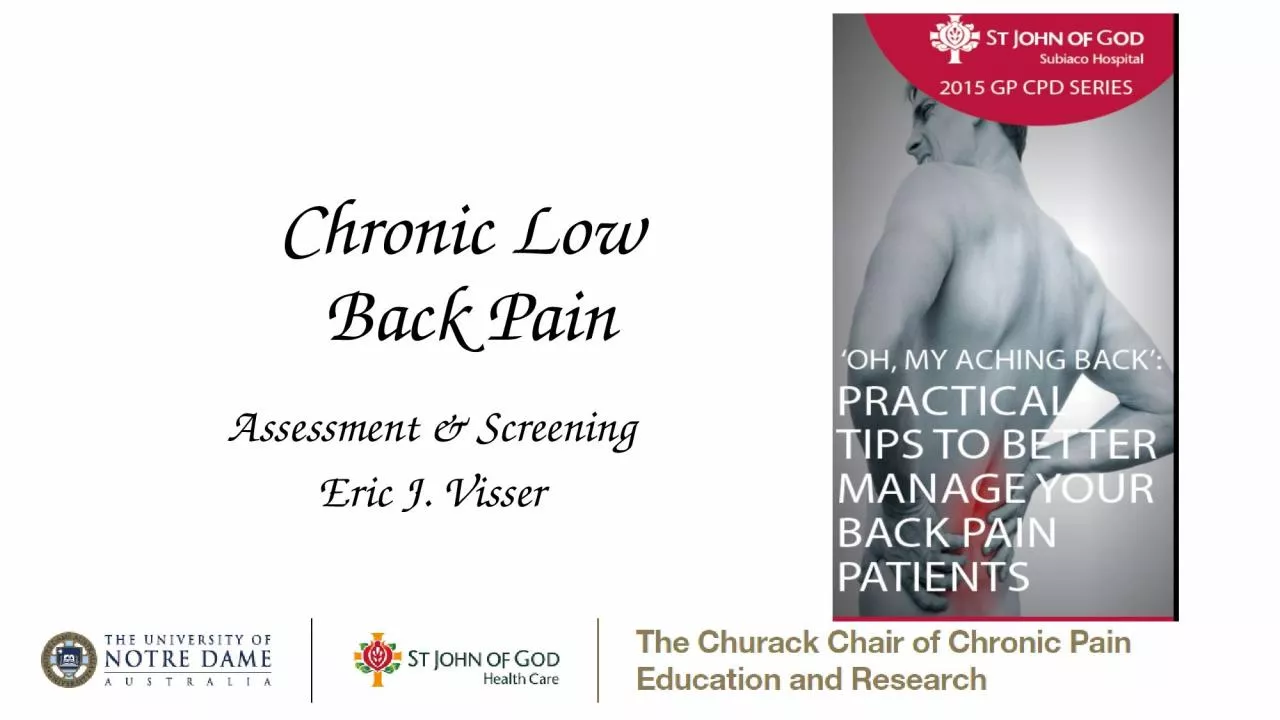

Eric J Visser CLBP is common amp consequential CLBP pain 3M in low back region ribs buttocks flanks 10 of population 22 million Australians right now 10 of GP visits 50 of pain clinic visits ID: 935362
Download Presentation The PPT/PDF document "Chronic Low Back Pain Assessment & ..." is the property of its rightful owner. Permission is granted to download and print the materials on this web site for personal, non-commercial use only, and to display it on your personal computer provided you do not modify the materials and that you retain all copyright notices contained in the materials. By downloading content from our website, you accept the terms of this agreement.
Slide1
Chronic Low Back Pain
Assessment & ScreeningEric J. Visser
Slide2Slide3CLBP is common & consequential
CLBP: pain ≥ 3M in low back region (ribs, buttocks, flanks)10% of population
2.2 million Australians right now
10% of GP visits
50% of pain clinic visits
Top 10 health care burdens worldwide
(disability)
$35 billion per year (health care, productivity)
Slide4Causes of LBP
Acute LBP
‘chronic’ in 20% of cases
Acute low back pain
Injury (work, sports)
(lifting, twisting, straining
,
repetitive loading)
Spondy
l
osis (‘spinal’ ‘degeneration’) (discs, facets) Pathology (red flags) Surgery (‘failed back surgery syndrome’) Pregnancy Fitness ( BMI, deconditioning, smokers) Genetics (disc pain, connective tissue/hypermobility) Parreira P, Maher CG, Latimer J, Steffens D, Blyth F, Li Q, Ferreira ML. Can patients identify what triggers their back pain? Secondary analysis of a case-crossover study. Pain 2015 Jun 1. PMID: 26039901
Slide5Assessment
Bio-medical-psycho-social approachHistory
Classification of LBP
Questionnaires
Examination
Special tests
MRI
Slide6History
Who is the patient?What
type of LBP; ± leg pain;
neuropathic pain
What
is the cause?
When (timing)?How did it happen?
(nature of injury, mechanisms & forces involved)
Why
is the patient presenting NOW?
Red flags
(screening questions) (T.I.N.T)Yellow flags (psycho-social predictors of chronic pain & disability) (C.H.A.M.P.S)
Slide7Classifying CLBP
Timing?
- chronic ≥3M - acute-on-chronic (‘flare ups’)
Type of LBP?
-
non-specific?
(80%) - specific? (‘pain generator’ identified) (20%)
± Leg pain?
(20%)
- referred pain (musculoskeletal structures) (2/3
rd
) - radicular pain (‘sciatica’) (1/3rd) (10% of cases overall)± Neuropathic pain? (up to 80% of CLBP) Chronic non-specific low back with leg pain
Slide8Specific causes of CLBP The search for pain generators
Discs (40%)
- internal disc disruption (IDD)
- high intensity zone (HIZ)
- Modic changes (‘inflamed’ end plates)
Facet joints (20%)
Sacro
-iliac joints (20%)
Slide9Specific CLBP
Spinal stenosis - back pain - leg pain
- claudication
- tight canal on imaging
- supermarket trolley test
Pars defects
Slide10Specific CLBP
Cluneal neuralgia (10%)
Unilateral low back
Buttock pain (leg)
Tender over iliac crest
Altered sensation over buttock
Due to rotation
, twisting?Vertebral fractures?
Slide11Specific CLBP
Myofascial pain
- trigger points
- gluteal muscles
- latissimus
dorsi
fascia - greater trochanters
Slide12Radicular leg pain (‘sciatica’)
Neuropathic leg pain
due to a nerve root lesion
Not common
(10%)
L5
or S1
nerve root (90%)Sensory signs & symptoms
(foot numbness, allodynia, paresthesiae)Motor signs & symptoms
(foot/ankle, big toe weakness, ankle reflexes)
+ SLR & slump tests
Clinical & MRI (CT) needed to make diagnosis
Lumbar disc protrusion compresses nerve root below it - L4/L5 disc = L5 nerve root - L5/S1 disc = S1 nerve root
Slide13Red flags T.I.N.T
T
umour
I
nfection
(discitis, IVDU, Hep C) Inflammation (spondyl
itis) (spinal ‘inflammation’)
N
eurological
(cauda equina: saddle, bladder & bowel, weak/numb legs) Trauma (fractures) Most important screening questions: - cancer? - age > 70 or < 20? - steroids? - fall? - injecting drugs?
Slide14Yellow flags (CHAMPS)
Predict chronic pain & disability
C
atastrophizing
(ruminating, injustice
,
work dissatisfaction
)
H
yper-vigilant
A
nxious (panic & PTSD) MedicalizedPassive (‘fix me’, compensation) Substance overuse - chemical coping, addiction - smoking, OTCs, opioidsS
tress SZ George, JM
Beneciuk
MC Musculoskeletal Disorders 2015
Slide15LBP examination
Keep it simpleLook for the 4Rs…
Reasons
for
pain?
- physical examination does
not reliably ID spinal pain generators
- may ID peripheral pain generators?
R
adicular leg pain?
R
estrictions? (functional impairments: can they walk & work?)Red flags?
Slide16LBP examination
Watch, walk & weakness (gait, power foot/ankle, big toe)
Poke & prick
-
cluneal
nerves (iliac crest tenderness, ∆ in sensation over buttock)
- trigger points (latissimus dorsi fascia, gluteal compartment)
- greater trochanters (lateral thigh)
- L4-S1 dermatomes (sensation in shin & foot)
Slump & stretch
(provocation tests)
- straight leg raise (SLR) - slump test Hammer & hit - ankle & knee reflexes)
Slide17Straight leg raise & slump testRadicular leg pain
Bigos
S, Bowyer 0,
Braen
G, et al. Acute low back pain problems in adults: Clinical Practice Guideline, Quick Reference Guide Number. 14. Rockville, MD: U.S. Department of Health and Human Services, Public Health Service, Agency for Health Care Policy and Research. AHCPR Pub. No. 95-0643. December 1994.
Available from:
http://www.chirobase.org/07Strategy/AHCPR/clinicians.pdf
Slide18Lumbar MRI
Only order to identify red flags or radiculopathy
MRI not that helpful in identifying ‘pain generators’
Severity of MRI changes ≠ severity of back pain
MRI is best screening test for;
-
T
umour -
Infection (discitis)
-
I
nflammation (ankylosing spondylitis)
- Neurological (cauda equina, cord, root) - Trauma (may miss fractures)2nd line: CAT scan
Slide19Questionnaires
DN4
or
PainDETECT
Q
(identifies
neuropathic pain)
STarTBack Q (yellow flags, chronicity & disability)
Slide20CLBP: key messages
Leading cause of chronic pain
& disability
Classify by timing
,
type of LBP, leg pain, neuropathic pain?
Mostly ‘
non-specific’ CLBP (80%)
Radicular leg pain is not
that common
(10% of cases)
T.I.N.T
(red flags) C.H.A.M.P.S (yellow flags) (predict chronic pain & disability) Examination (watch, walk, poke, prick, slump, stretch, hammer) MRI (only for red flags or radiculopathy)
Slide21Thank you
Slide22Risk of developing CLBP increases by 10% for every life-stress (yellow flag) around the time of injury
Risk of
chronic pain
over 12M
90% risk if 6 stressors
10% risk
if
0 stressors
Stresses